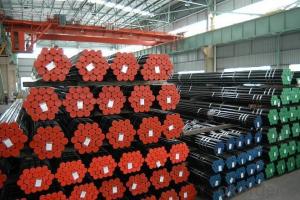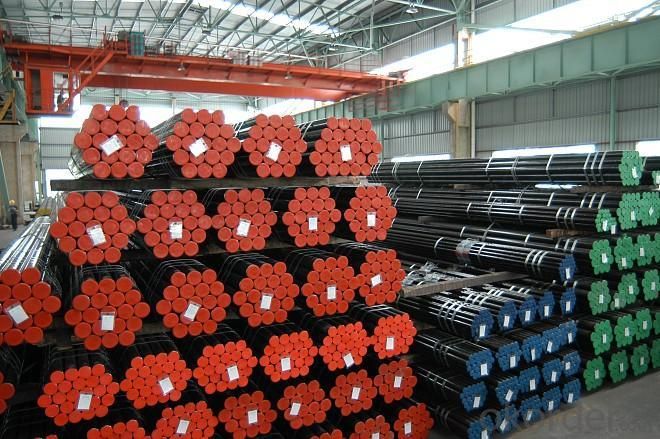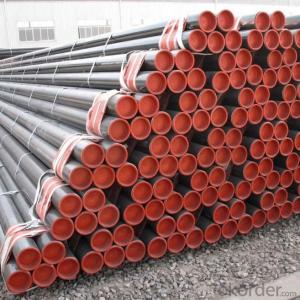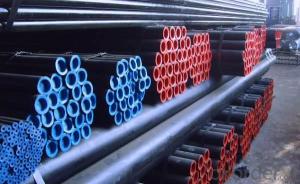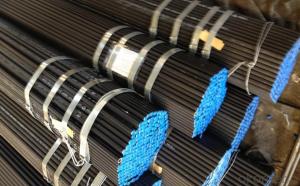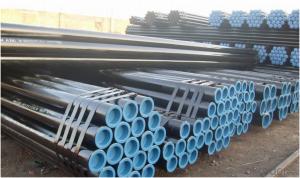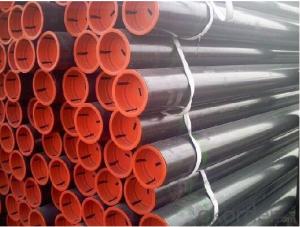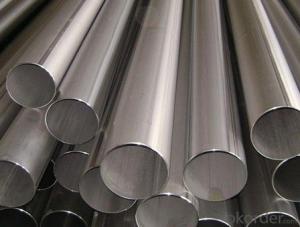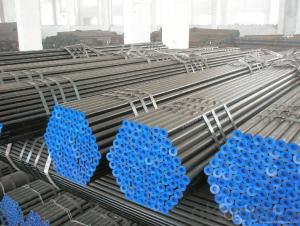Carbon Seamless Steel Pipe API 5L, ASTM A53, Various Size
- Loading Port:
- Tianjin
- Payment Terms:
- TT OR LC
- Min Order Qty:
- 25 m.t.
- Supply Capability:
- 10000 m.t./month
OKorder Service Pledge
OKorder Financial Service
You Might Also Like
1、Structure of Carbon Seamless Steel Pipe API 5L, ASTM A53, Various Size Good Price:
Seamless pipe is formed by drawing a solid billet over a piercing rod to create the hollow shell. As the manufacturing process does not include any welding, seamless pipes are perceived to be stronger and more reliable. Historically seamless pipe was regarded as withstanding pressure better than other types, and was often more easily available than welded pipe.
2、Main Features of Carbon Seamless Steel Pipe API 5L, ASTM A53, Various Size Good Price:
• High manufacturing accuracy
• High strength
• Small inertia resistance
• Strong heat dissipation ability
• Good visual effect
• Reasonable price
3、Carbon Seamless Steel Pipe API 5L, ASTM A53, Various Size Specification Good Price:
Standard | GB, DIN, ASTM ASTM A106-2006, ASTM A53-2007 |
Grade | 10#-45#, 16Mn 10#, 20#, 45#, 16Mn |
Thickness | 8 - 33 mm |
Section Shape | Round |
Outer Diameter | 133 - 219 mm |
Place of Origin | Shandong, China (Mainland) |
Secondary Or Not | Non-secondary |
Application | Hydraulic Pipe |
Technique | Cold Drawn |
Certification | API |
Surface Treatment | factory state or painted black |
Special Pipe | API Pipe |
Alloy Or Not | Non-alloy |
Length | 5-12M |
Outer Diameter | 21.3-610mm |
Grade | 20#, 45#, Q345, API J55, API K55, API L80, API N80, API P110, A53B |
Standard | ASME, ASTM |
1) Material:20#(ASTM A 106/A53 GRB.API5LGRB,GB),45#,16Mn,10#.
2) Specification range:OD:21.3-610mm,WT:6-70mm,length:6-12m or according to the requirement of clients.
3) Excutive standards:GB,ASME API5L.ASTM A 106/A53,Despite of the above standards,we can also supply seamless steel pipe with standard of DIN,JIS,and so on,and also develop new products according to the requirements of our clients!
4) Surface:black lacquered,varnish coating or galvanized.
5) Ends:Beveled or square cut,plastic capped,painted.
6) Packing:bundles wrapped with strong steel strip,seaworthy packing.
4、Packaging & Delivery
Packaging Details: | seaworthy package,bundles wrapped with strong steel strip |
Delivery Detail: | 15-30days after received 30%TT |
5、FAQ of Carbon Seamless Steel Pipe API 5L, ASTM A53, Various Size Good Price:
①How is the quality of your products?
Our products are manufactured strictly according to national and internaional standard, and we take a test
on every pipe before delivered out. If you want see our quality certifications and all kinds of testing report, please just ask us for it.
Guaranteed: If products’ quality don’t accord to discription as we give or the promise before you place order, we promise 100% refund.
②How about price?
Yes, we are factory and be able to give you lowest price below market one, and we have a policy that “ for saving time and absolutely honest business attitude, we quote as lowest as possible for any customer, and discount can be given according to quantity”,if you like bargain and factory price is not low enough as you think, just don’t waste your time.Please trust the quotation we would give you, it is professional one.
③Why should you chose us?
Chose happens because of quality, then price, We can give you both.Additionally, we can also offer professional products inquiry, products knowledge train(for agents), smooth goods delivery, exellent customer solution proposals.Our service formula: good quality+good price+good service=customer’s trust
SGS test is available, customer inspection before shipping is welcome, third party inspection is no problem.
6、Carbon Seamless Steel Pipe API 5L, ASTM A53, Various Size Good Price Images:
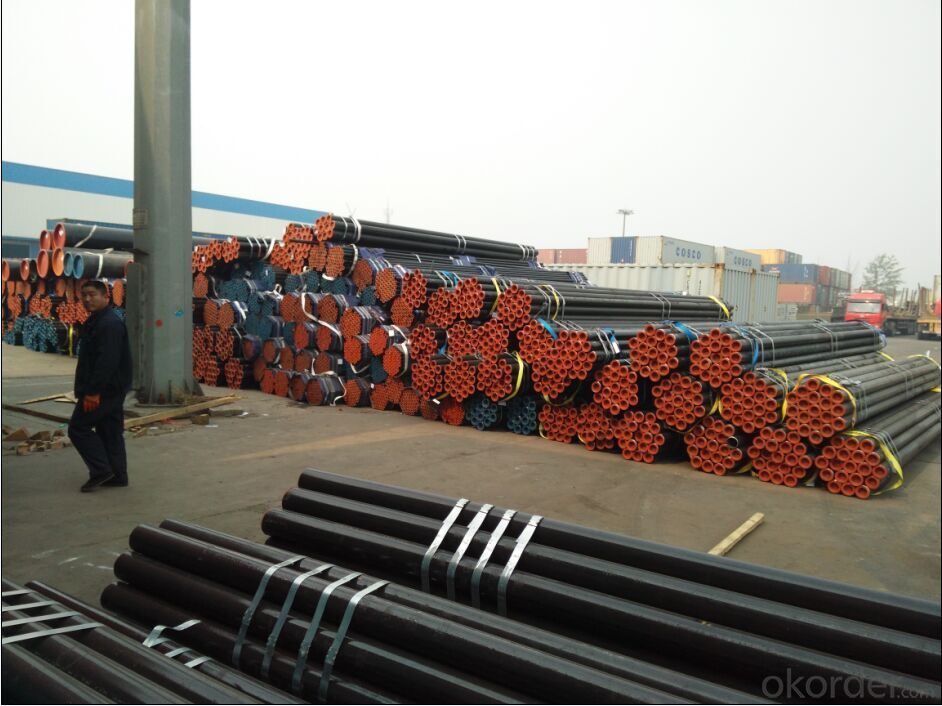
- Q: What is the cost of steel pipes compared to other pipe materials?
- The cost of steel pipes is typically higher compared to other pipe materials such as PVC or copper.
- Q: Are steel pipes suitable for semiconductor manufacturing plants?
- Yes, steel pipes are suitable for semiconductor manufacturing plants. Steel pipes are known for their durability, strength, and resistance to corrosion, making them an excellent choice for various industrial applications, including semiconductor manufacturing. In semiconductor manufacturing plants, various chemicals and gases are used throughout the production process. Steel pipes are highly resistant to corrosion and can withstand the harsh chemicals and gases commonly found in semiconductor manufacturing environments, ensuring the integrity and longevity of the piping system. Furthermore, steel pipes can handle high-pressure applications, which are often required in semiconductor manufacturing plants. They have excellent mechanical properties and can withstand heavy loads and stress, making them reliable for transporting fluids and gases at high pressures. Another advantage of steel pipes is their flexibility in terms of size and shape. Semiconductor manufacturing plants often require a complex and intricate piping system to accommodate different processes and equipment. Steel pipes can be easily customized and fabricated to fit specific requirements, allowing for efficient and seamless integration into the plant's infrastructure. Overall, steel pipes offer the necessary qualities and characteristics required for semiconductor manufacturing plants. Their durability, corrosion resistance, high-pressure capabilities, and flexibility make them a suitable choice for transporting chemicals and gases in this industry.
- Q: Can steel pipes be used for structural supports in buildings?
- Yes, steel pipes can be used for structural supports in buildings. Steel pipes are commonly used in construction due to their high strength, durability, and ability to withstand heavy loads. They provide excellent structural support, especially in applications that require long spans or high load-bearing capacities. Additionally, steel pipes are resistant to corrosion and can be easily connected or welded, making them a popular choice in building construction.
- Q: How are steel pipes used in the manufacturing of sewage treatment plants?
- Steel pipes are used in the manufacturing of sewage treatment plants for various purposes, including the transportation of wastewater, the distribution of chemicals and additives, and the construction of various components such as tanks, pumps, and pipelines. Steel pipes are preferred due to their strength, durability, and resistance to corrosion, ensuring reliable and long-lasting infrastructure for the efficient operation of sewage treatment plants.
- Q: How are steel pipes used in fire protection systems?
- Fire protection systems rely on the inclusion of steel pipes, which serve as an essential component for the distribution of water and fire suppressants within buildings. These pipes are renowned for their robustness, longevity, and ability to endure extreme temperatures, rendering them optimal for withstanding the harsh conditions associated with fires. Within fire protection systems, steel pipes are commonly utilized to establish an interconnected network of pipes responsible for supplying water to sprinkler heads or fire hydrants throughout a building. This network guarantees that water is readily accessible to suppress or extinguish fires during emergencies. One of the primary advantages of steel pipes in fire protection systems is their capacity to withstand the elevated pressure and flow rates necessary for effective fire suppression. Steel pipes can handle forceful water flow with ease, enabling prompt and efficient distribution of water to affected areas, thereby aiding in the control and extinguishing of fires in the shortest possible time. Additionally, steel pipes possess an inherent resistance to corrosion, a crucial attribute for preserving the integrity of fire protection systems over time. Corrosion has the potential to weaken pipes, leading to leaks or complete failure, which can prove catastrophic during a fire incident. However, steel pipes possess an extended lifespan and require minimal maintenance when compared to other pipe materials, ensuring the longevity and dependability of the system for many years to come. Moreover, steel pipes are frequently selected for use in fire protection systems due to their fire-resistant properties. Steel inherently possesses the ability to withstand high temperatures without deformation or compromising its structural integrity. This characteristic is of utmost importance in fire protection systems, as it enables the pipes to remain intact and continue delivering water even amidst a fire, ensuring the safety of occupants and minimizing damage to the building. In conclusion, steel pipes hold a pivotal role in fire protection systems by guaranteeing the reliable and efficient distribution of water or fire suppressants. Their strength, durability, resistance to high temperatures, and corrosion resistance make them the ideal choice for effectively combating fires and safeguarding lives and property.
- Q: How are steel pipes used in offshore drilling platforms?
- Steel pipes are used in offshore drilling platforms to transport drilling fluids, such as mud and cement, from the drilling rig to the wellbore. These pipes are also used to extract oil and gas from the well by connecting the drilling rig to the subsea wellhead. Additionally, steel pipes provide structural support and stability to the drilling platform, ensuring safe and efficient operations in harsh offshore environments.
- Q: What is the difference between steel pipes and HDPE pipes?
- Steel pipes are made of steel, which is a sturdy and durable material. They are commonly used in industrial applications and can withstand high pressure and extreme temperatures. HDPE pipes, on the other hand, are made of high-density polyethylene, a type of plastic known for its flexibility and corrosion resistance. They are commonly used in water supply systems and underground applications. The main differences between steel pipes and HDPE pipes lie in their material composition, properties, and applications.
- Q: How do steel pipes differ from other types of pipes?
- Steel pipes differ from other types of pipes in a few key ways. Firstly, steel pipes are known for their strength and durability. They have a high resistance to heat, pressure, and corrosion, making them suitable for a wide range of applications. This strength also allows steel pipes to withstand heavy loads and provide a long service life. Another distinguishing feature of steel pipes is their versatility. Steel pipes can be manufactured in various shapes and sizes to meet specific project requirements. This adaptability makes them a popular choice for a wide range of industries, including construction, oil and gas, water treatment, and manufacturing. Steel pipes also offer excellent thermal conductivity, meaning they can efficiently transfer heat from one area to another. This makes them suitable for applications such as heating and cooling systems, as well as for transporting hot fluids or gases. Furthermore, steel pipes are known for their resistance to fire. They have a high melting point and do not easily catch fire or contribute to the spread of flames. This property is crucial in applications where fire safety is a concern, such as in buildings or industrial facilities. Lastly, compared to other types of pipes, steel pipes have a higher initial cost. However, their long-term benefits, such as their durability and low maintenance requirements, often outweigh the initial investment. Steel pipes are also highly recyclable, making them an environmentally friendly choice. In summary, steel pipes stand out from other types of pipes due to their strength, durability, versatility, excellent thermal conductivity, fire resistance, and recyclability. These qualities make steel pipes a preferred option for a wide range of applications in various industries.
- Q: How are steel pipes insulated to prevent condensation?
- Steel pipes are insulated to prevent condensation by wrapping them with a layer of insulation material, such as foam or fiberglass, which creates a barrier between the cold surface of the pipe and the surrounding air. This insulation helps to maintain the temperature of the pipe, preventing it from reaching the dew point and thus avoiding condensation.
- Q: How are steel pipes used in automotive manufacturing?
- Steel pipes are widely used in automotive manufacturing for various purposes. One of the primary applications of steel pipes in this industry is for the exhaust system. The exhaust system in vehicles is responsible for the safe removal of harmful gases produced during the combustion process. Steel pipes are used to create the exhaust manifold, which collects the exhaust gases from the engine cylinders and directs them towards the exhaust pipe. Furthermore, steel pipes are also used in the manufacturing of the chassis and frame of vehicles. The chassis provides structural support and helps maintain the overall strength and stability of the vehicle. Steel pipes, due to their high strength and durability, are ideal for creating the chassis and frame. These pipes are often welded together to form a rigid and robust structure that can withstand various forces and impacts. Additionally, steel pipes find applications in the suspension system of automobiles. The suspension system is responsible for providing a comfortable and smooth ride by absorbing shocks and vibrations. Steel pipes are used in the manufacturing of suspension components such as control arms, tie rods, and sway bars. These components help maintain the stability, handling, and overall performance of the vehicle. Moreover, steel pipes are utilized in the fuel system of automobiles. They are used to transport fuel from the fuel tank to the engine. These pipes need to be resistant to corrosion and have high tensile strength to ensure the safe and efficient delivery of fuel. In conclusion, steel pipes play a crucial role in automotive manufacturing. They are used in various applications such as the exhaust system, chassis and frame construction, suspension system, and fuel system. The use of steel pipes in these areas ensures the durability, strength, and performance of vehicles while maintaining safety and efficiency.
Send your message to us
Carbon Seamless Steel Pipe API 5L, ASTM A53, Various Size
- Loading Port:
- Tianjin
- Payment Terms:
- TT OR LC
- Min Order Qty:
- 25 m.t.
- Supply Capability:
- 10000 m.t./month
OKorder Service Pledge
OKorder Financial Service
Similar products
Hot products
Hot Searches
Related keywords
